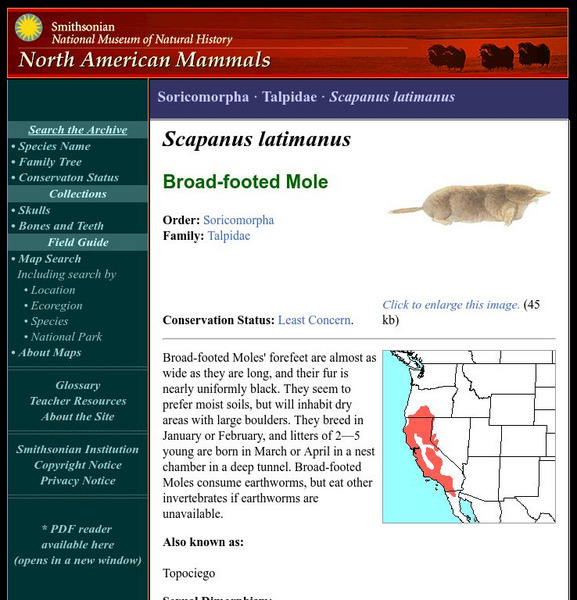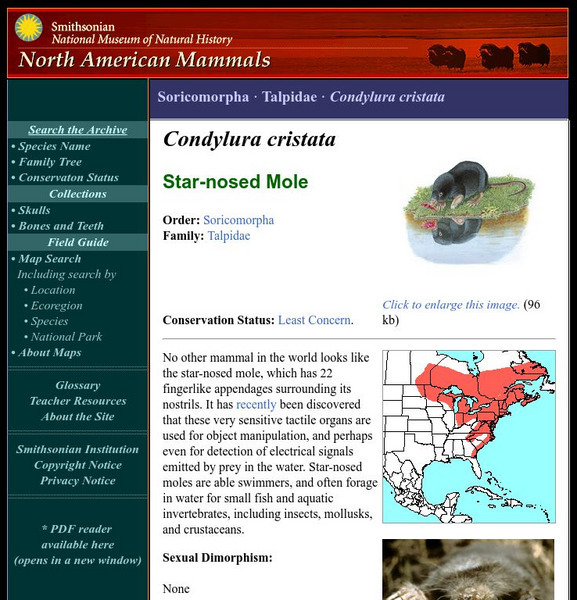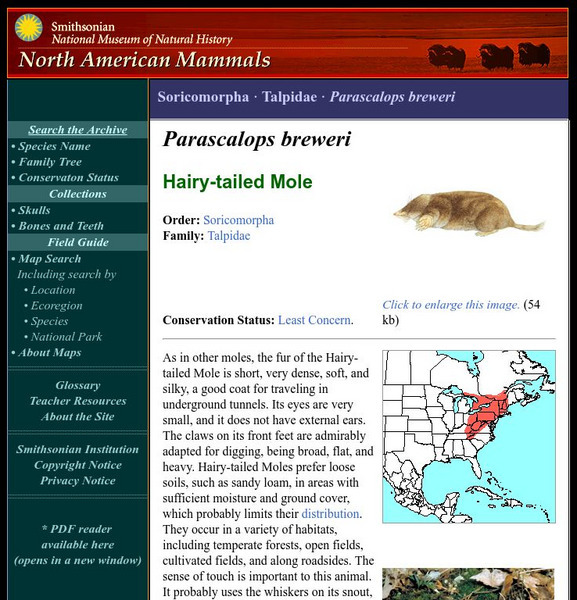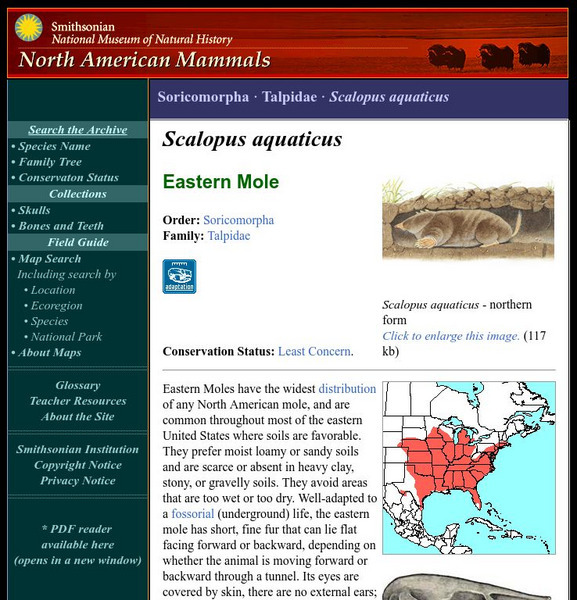Chem Tutor
Chem Tutor: Basic Stiochiometry
Detailed discussion of stoichiometry, mols, and percents. Includes examples showing dimensional analysis (factor-lable method) and a link to the mole road map (a diagram which leads one through the stoichiometric problem-solving process).
CK-12 Foundation
Ck 12: Chemistry Simulation: Mole Carnival
[Free Registration/Login Required] In the mole carnival, students count the number of atoms and particles in different objects found at the carnival. As students work to find the number of particles, they practice counting particles by...
Alabama Learning Exchange
Alex: Balancing Chemical Reactions
Students will participate in a guided inquiry activity using manipulatives to learn how to balance chemical reactions. This activity was developed in cooperation with Michelle Holdbrooks at Thompson High School...
Encyclopedia of Life
Encyclopedia of Life: Star Nosed Mole
The Encyclopedia of Life presents this in-depth overview of Star-nosed Moles (Condylura cristata), including their habitats, size, conservation status, and much more. Images of this species and maps of its global distribution can also be...
Science and Mathematics Initiative for Learning Enhancement (SMILE)
Smile: Moles, Moles, Moles
This is an activity that is designed to introduce students to the concept of the mole.
Simon Fraser University
Chem1 Virtual Textbook: Molar Mass of a Gas Mixture
The General Chemistry Virtual Textbook, or Chem 1, is broken into several sections covering various aspects of topics related to chemistry. This section deals with the molar mass of gas mixtures. Applications of Dalton's law are also...
Other
Celebrate Mole Day at 6:02 on October 23 !!!
A page describing how Mole Day is celebrated at the Massachusetts Academy for Mathematics and Science. Some ideas for celebrations can be found here.
Encyclopedia of Life
Encyclopedia of Life: Eastern Mole
The Encyclopedia of Life presents this in-depth overview of Eastern Moles (Scalopus aquaticus), including their habitats, size, conservation status, and much more. Images of this species and maps of its global distribution can also be...
Sophia Learning
Sophia: Ideal Gas Law Equation: Lesson 1
This lesson will explain the variables in the ideal gas law equation. It is 1 of 2 in the series titled "Ideal Gas Law Equation."
Sophia Learning
Sophia: Ideal Gas Law Variables and Relationships: Lesson 1
This lesson will explain the relationships shown by the ideal gas law. It is 1 of 2 in the series titled "Ideal Gas Law Variables and Relationships."
Sophia Learning
Sophia: Mixed Conversion Problems: Lesson 2
This lesson explains how to approach practice problems when trying to determine what final quantity is being asked for. It is 2 of 2 in the series titled "Mixed Conversion Problems."
Sophia Learning
Sophia: Converting From Grams to Moles: Lesson 2
This lesson demonstrates how to convert from grams to moles. It is 2 of 2 in the series titled "Converting from Grams to Moles."
Sophia Learning
Sophia: Converting From Moles to Grams: Lesson 2
This lesson demonstrates how to convert from moles to grams. It is 2 of 2 in the series titled "Converting from Moles to Grams."
Smithsonian Institution
Smithsonian National Zoo: Naked Mole Rat
As part of the Amazonia exhibit at the National Zoo, this site highlights various facts and interesting information on the Naked Mole-Rat. In addition to several pictures, the site provides a description and information on habitat, diet,...
Environmental Chemistry
Environmental chemistry.com: Molar Mass Calculations
Provides a definition for both mole and molar mass and gives a step-by-step example problem to work through that shows how to compute molar mass. Also has a a molar mass calculator in which you can practice problems on.
Indiana University
Indiana University Northwest: Molar Mass
This site shows how to compute molar mass by working through an example.
Smithsonian Institution
National Museum of Natural History: American Mammals: Broad Footed Mole
Broad-footed Moles' forefeet are almost as wide as they are long, and their fur is nearly uniformly black. They seem to prefer moist soils, but will inhabit dry areas with large boulders. Learn more about the Scapanus latimanus, more...
Smithsonian Institution
National Museum of Natural History: American Mammals: Coast Mole
Coast Moles are difficult to distinguish from Townsend's Moles where their ranges overlap in the Pacific Northwest. Both have velvety, dark-gray fur and tiny eyes and ears that are hidden under their fur. Learn more about the Scapanus...
Smithsonian Institution
National Museum of Natural History: American Mammals: Townsend's Mole
The largest moles in North America, weighing in at 100 - 171 grams, Townsend's Moles live only in the lowlands on the western side of the Cascade Mountains, from northwestern California to extreme southwestern British Columbia. One...
Smithsonian Institution
National Museum of Natural History: American Mammals: Star Nosed Mole
No other mammal in the world looks like the star-nosed mole, which has 22 fingerlike appendages surrounding its nostrils. It has recently been discovered that these very sensitive tactile organs are used for object manipulation, and...
Smithsonian Institution
National Museum of Natural History: American Mammals: Hairy Tailed Mole
As in other moles, the fur of the Hairy-tailed Mole is short, very dense, soft, and silky, a good coat for traveling in underground tunnels. Its eyes are very small, and it does not have external ears. Learn more about the Parascalops...
Smithsonian Institution
National Museum of Natural History: American Mammals: Eastern Mole
Eastern Moles have the widest distribution of any North American mole and are common throughout most of the eastern United States where soils are favorable. They prefer moist loamy or sandy soils and are scarce or absent in heavy clay,...
Upper Canada District School Board
Tom Stretton's Chemistry Pages: The Mole Concept
Deepen your understanding of the mole in chemistry. Find out the origin of the term, and the formulas it represents.
Other
Widener University: Ideal Gas Law
At this site from the Widener University Department of Chemistry, you can try your skill with using the ideal gas law equation to solve problems. This page contains an interactive JavaScript form which delivers problem after problem. You...






















